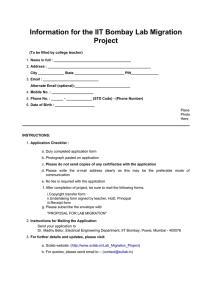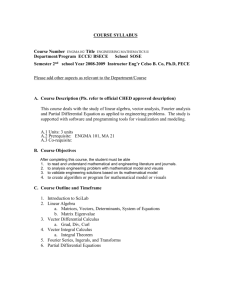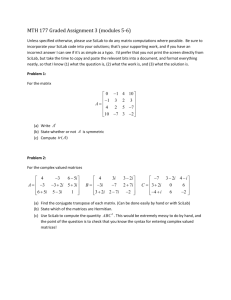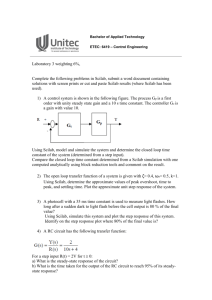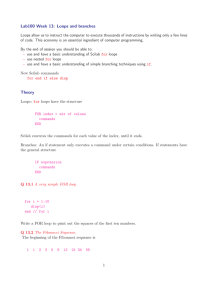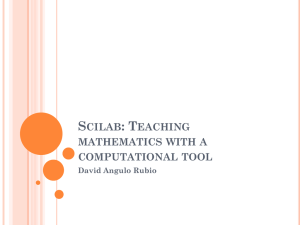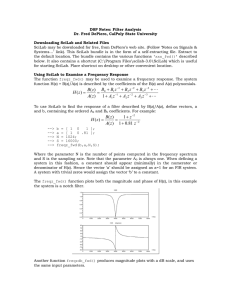Activity 1: Introduction to Scilab
advertisement
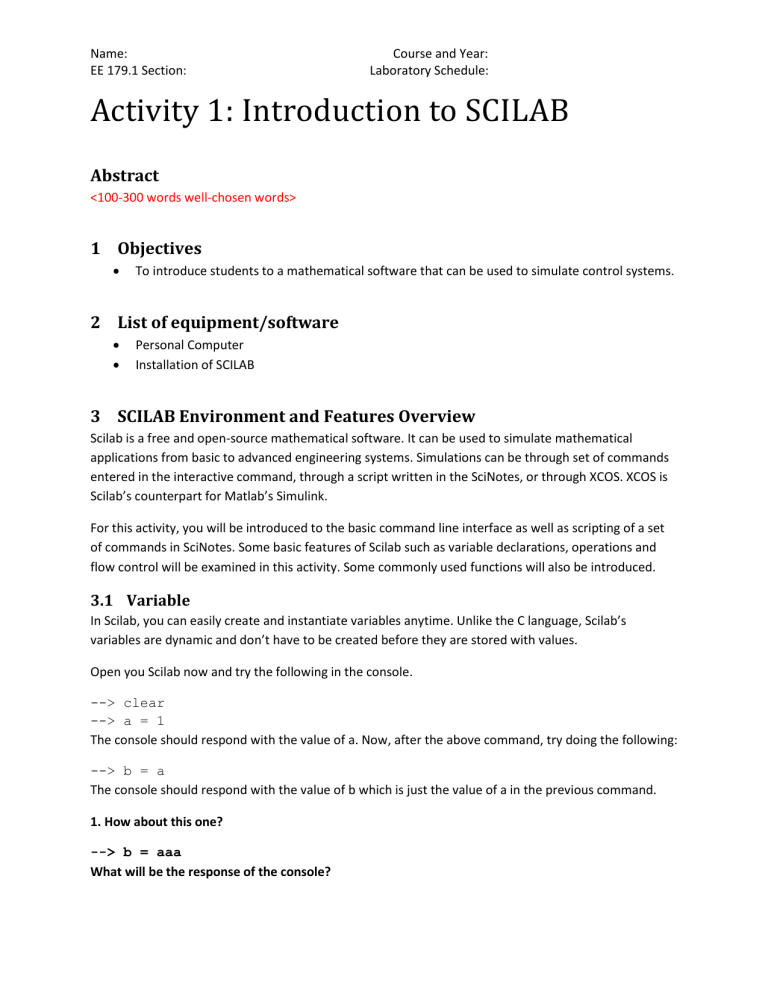
Name: EE 179.1 Section: Course and Year: Laboratory Schedule: Activity 1: Introduction to SCILAB Abstract <100-300 words well-chosen words> 1 Objectives To introduce students to a mathematical software that can be used to simulate control systems. 2 List of equipment/software Personal Computer Installation of SCILAB 3 SCILAB Environment and Features Overview Scilab is a free and open-source mathematical software. It can be used to simulate mathematical applications from basic to advanced engineering systems. Simulations can be through set of commands entered in the interactive command, through a script written in the SciNotes, or through XCOS. XCOS is Scilab’s counterpart for Matlab’s Simulink. For this activity, you will be introduced to the basic command line interface as well as scripting of a set of commands in SciNotes. Some basic features of Scilab such as variable declarations, operations and flow control will be examined in this activity. Some commonly used functions will also be introduced. 3.1 Variable In Scilab, you can easily create and instantiate variables anytime. Unlike the C language, Scilab’s variables are dynamic and don’t have to be created before they are stored with values. Open you Scilab now and try the following in the console. --> clear --> a = 1 The console should respond with the value of a. Now, after the above command, try doing the following: --> b = a The console should respond with the value of b which is just the value of a in the previous command. 1. How about this one? --> b = aaa What will be the response of the console? Name: EE 179.1 Section: Course and Year: Laboratory Schedule: Since aaa has not been assigned a value yet, it still does not exist. Another convenient feature of Scilab is that you can assign any datatype to a variable even after you had previously assigned a different datatype. For example: --> b = 1 --> b = “Hi, this is a string” --> b = [“this”,”is”, “a”, “vector/array”] These commands will not produce an error. The datatype of the variables in Scilab adapt to whatever value you store in it. You may have noticed that the last command is an array. Arrays in Scilab are values enclosed in “[“ and “]” with values separated by spaces or commas. You can also create a matrix by separating rows with a semicolon. --> an_array = [1, 3, 4] --> a_matrix = [1, 2; 4, 5] 𝟏 𝟐 𝟑 2. What will you enter in the command line if you want to assign a_matrix with [𝟒 𝟓 𝟔]? 𝟕 𝟖 𝟗 You can easily declare an array of sequence of numbers using “:” --> 1:10 // returns an array of numbers from 1 to 10 with an interval of 1 --> 1:2:10 // returns an array of numbers from 1 to 10 with an interval of 2 3.1.1 Polynomial You can easily create polynomial using the poly function read the help file for different methods of using the poly function. The simplest way is the following: --> s= poly(0,’s’) //this assign polynomial s^1 to the variable s. Now you can manipulate this variable similar to number. 3. Write the result of (s^2+2*s+1)/(s+1) as shown in the console. 3.2 Operators Scilab has a lot of operators in addition to basic arithmetic operations. Since Scilab operates on matrices by default, basic arithmetic operations are applied on matrices. Operator + * / Description Matrix addition Matrix subtraction Matrix Multiplication Matrix division. 𝐴/𝐵 = 𝐴 ∗ 𝐵−1 Name: EE 179.1 Section: \ ^ ‘ Course and Year: Laboratory Schedule: Matrix back-division. 𝐴\𝐵 = 𝐴−1 ∗ 𝐵 Matrix exponential. Transpose If you want element-wise operation using those operators, the operator is preceded with a “.” --> a = [1, 2; 3, 4] --> b = [3, 4; 5, 6] --> a + b ans = 4. 6. 8. 10. 4. Do a matrix multiplication and element-wise multiplication on a and b. What are the results? Are the results equal? 5. What is the result of a’? Accessing an element in an array or matrix is by calling the variable with a parenthesis. For example, to access the 1st element of b: --> b(1) //this will return 3. Matrix b is treated as a vector reading top to bottom starting from the left. This is the same as --> b(1,1) //accessing element in column 1 row 1. First index is for the row, the second is for the column. You can use the $ to indicate the index of the last element. --> b(1,$) //returns the last element of the first row. Sub-matrices can be extracted by putting an array or matrix as index. The content of the matrix index will be the rows/columns that will be included in the sub-matrix. You can use “:” to include all elements on that row/column. --> c = [1, 2 ,3; 4, 5, 6; 7, 8, 9] --> d = c([1,3],[1,2]) ans = 1. 2. 3. 8. --> e = c(:,1) //returns all the rows in the first column. 6. What is the result of c(1:3,$)? Name: EE 179.1 Section: Course and Year: Laboratory Schedule: 3.3 Flow Control The flow control in Scilab can be done with if then/else statements, select/case , return, for loop, do and while loops. In addition, keywords such as break, continue, pause, abort are also useable to alter the flow of a set of Scilab commands. The syntax for this is in described in detailed in the Help menu of Scilab. To access the Help, type help in the command line or click the help button in the menu bar. 3.4 Functions in Scilab You can create a reuseable set of commands as a function in Scilab. The basic syntax is the following: FUNCTION [y1,…, yn]= functionname(x1, …, xm) //some statements or commands here ENDFUNCTION 3.4.1 Some of the commonly used functions in Scilab Refer to the Help menu for details 1. 2. 3. 4. 5. 6. 7. 8. 9. 10. 11. 12. 13. 14. 15. 16. 17. 18. 19. 20. plot – used to plot expressions in Scilab. poly – function to create a polynomial. roots – Solve the roots of a polynomial coeff – extract the coefficients of a polynomial. evstr - evaluate a string of Scilab statements or commands csim – Simulation of a linear system. (time response) ones – Generate a matrix of ones zeros – Generate a matrix of zeroes rand – generate a matrix of random values eye – generate an identity matrix. inv – inverse of a matrix diag – extract the diagonal of matrix abs – absolute value real, imag, complex – for complex numbers conj – conjugate of a complex pfss – partial fraction expansion of a give transfer function syslin – system linear definition ss2tf – State-space representation to transfer function conversion tf2ss – Transfer function to state-space representation ssrand – random system generator. 3.5 Batch Commands or Scripting Scilab has an integrated text editor called SciNotes for creating and editing Scilab scripts. A set of commands or statements can be written in a Scilab script that can be ran or executed in a single action. Name: EE 179.1 Section: Course and Year: Laboratory Schedule: SciNotes has some advance text editing functionalities for coding like parenthesis matching and syntax highlighting. Open Scinote by clicking the notebook icon below the menu bar. After opening the SciNotes, do the following: 7. Write the following in the editor: a = [0:0.1:2*%pi] b = “this is executed after a=1” plot(a,sin(2*a)) //end What is the result or the behavior of the above statements in the console after executing the script? 8. Write a function called myfunct that accepts two parameters A and B. The function will return the result of (A+B)*B. Execute the script what is the result? 9. Call the function you created in #8 and pass as parameters the values 3 and 9. What is the result? 10. What will your function return if the parameters are [1,2,3] and [4; 6;7]? 11. How about [1, 2, 3 ; 3, 5, 1; 5 6 -1] and [3, -1, 4 ; -3, 5, 1; -5 6 -1]? 12. Do you have to re-execute your function from SciNotes? Why? 3.6 Answers to Questions 4 Conclusion <Write your conclusion about the things you did in this lab>
